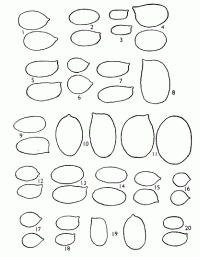|
 Hygrophorus brunneus Hygrophorus brunneus
SynonymsCantharellus brunneus
BiostatusPresent in region - Indigenous
Images (click to enlarge)
Caption: Spores X 2000 1. Hygrophorus salmonipes 2; H. elsae; 3, H .julietae; 4, H. variabilis; 5, H. lilaceo-lamelllatus; 6, H. muritaiensis; 7, H. keithgeorgei; 8, H. pseudococcineus; 9, H. rubro-carnosus; 10, H. miniceps; 11, H. procerus; 12, H. multic |  |
Article: Stevenson, G. (1963) [1962]. The Agaricales of New Zealand: IV. Kew Bulletin 16(3): 373–384.
Description: Pileus 0.5-1 cm. diam., light brown, darker at centre and with dark radial striations,
convex, umbilicate, tending to be crimped or waved at edge, matt to subfibrillose;
flesh brown. Gills decurrent, forking in larger specimens, distant. Stipe 1-1.5
cm. X l-2 mm., fawn to light brown, velvety to subfibrillose, fringed with white
hyphae at base, solid, rather tough. Spores 7 X 5 µm., hyaline. Basidia
30-35 X 5 µm. four-spored.
Habitat: habitat: attached to moss or rooting on banks in the bush, Wellington
Botanic Garden, 2.6.19491 Levin, 18.6.1949, both Stevenson.
Notes: Gleland remarks, 'This species is probably better placed under Omphalia', but,
as it has Hygrophoroid basidia and gill trama it is here placed in Hygrophorus
subgenera. Hygrocybe. The exact colour of the spore print needs to be determined.
Article: Horak, E. (1971). A contribution towards the revision of the Agaricales (Fungi) from New Zealand. New Zealand Journal of Botany 9(3): 403-462 (http://www.rsnz.org/publish/abstracts.php).
Notes: This doubtful species was described in Cantharellus by Cleland although he
commented that it was probably better placed in Omphalia. Type material has not
been studied.
|